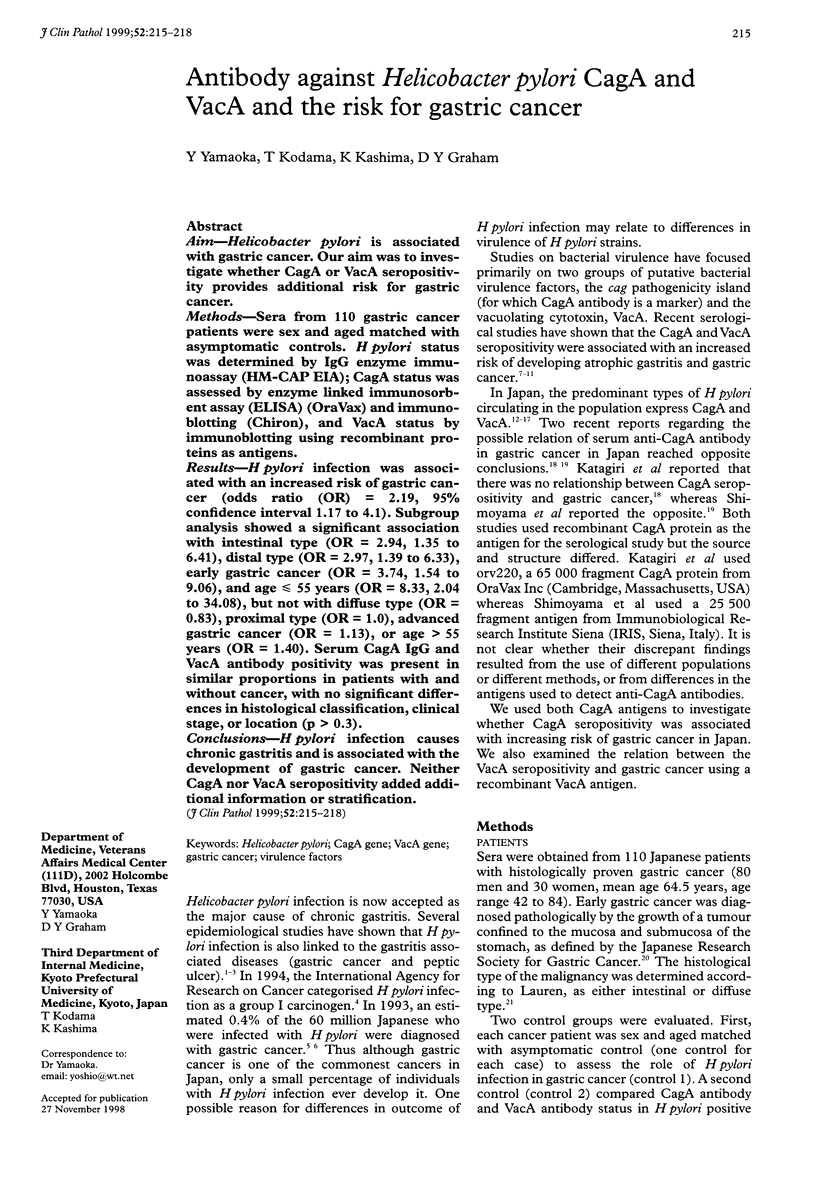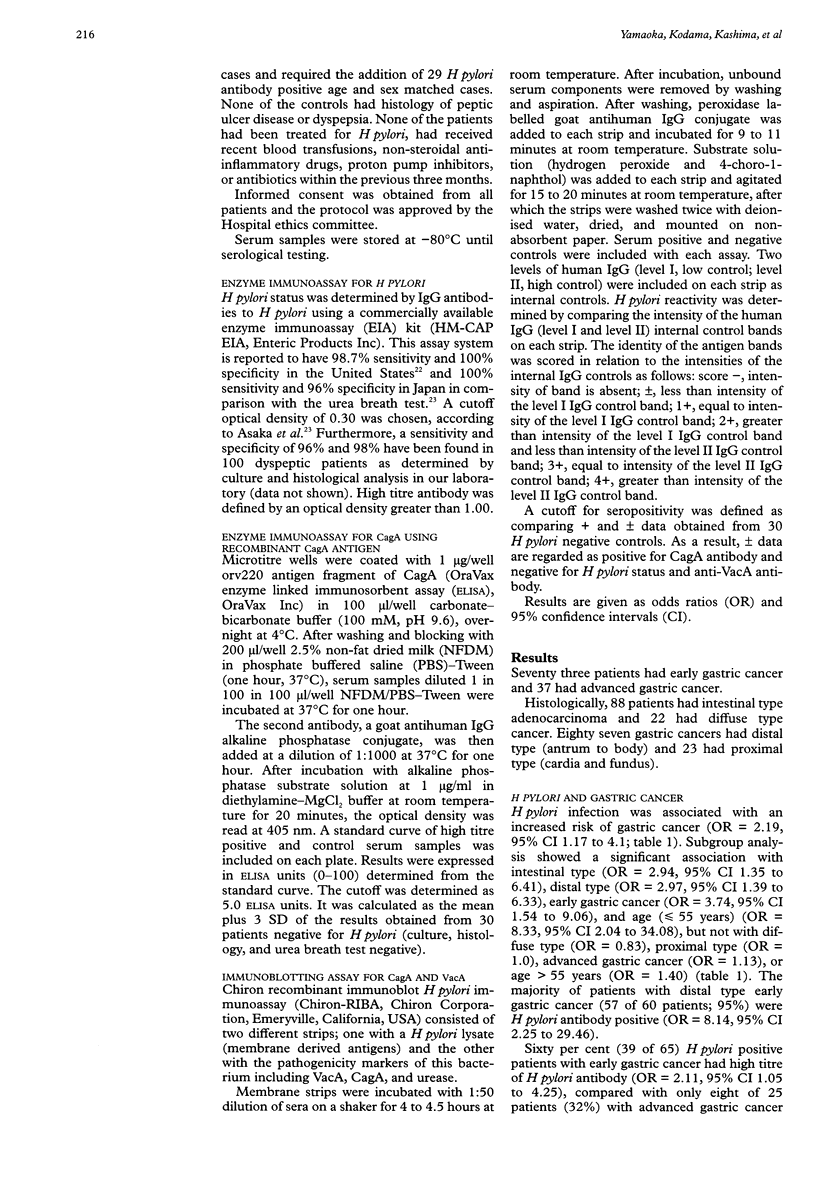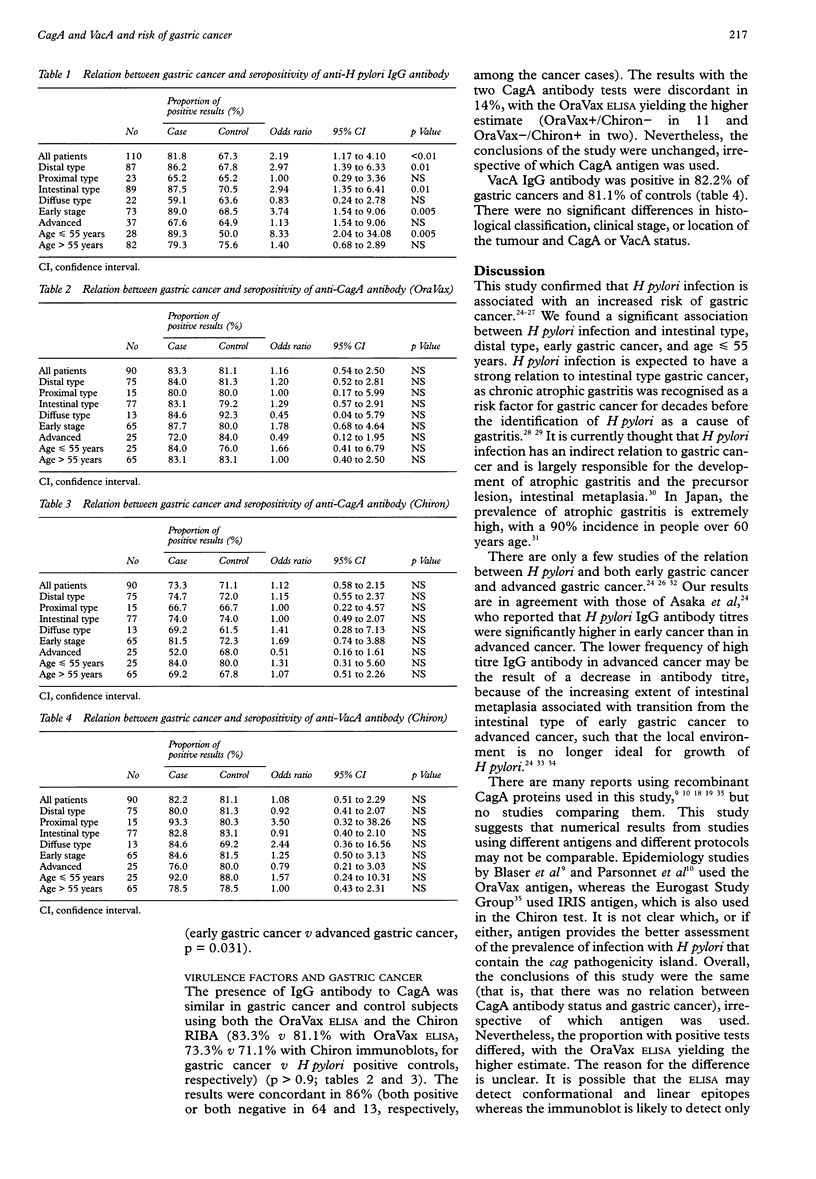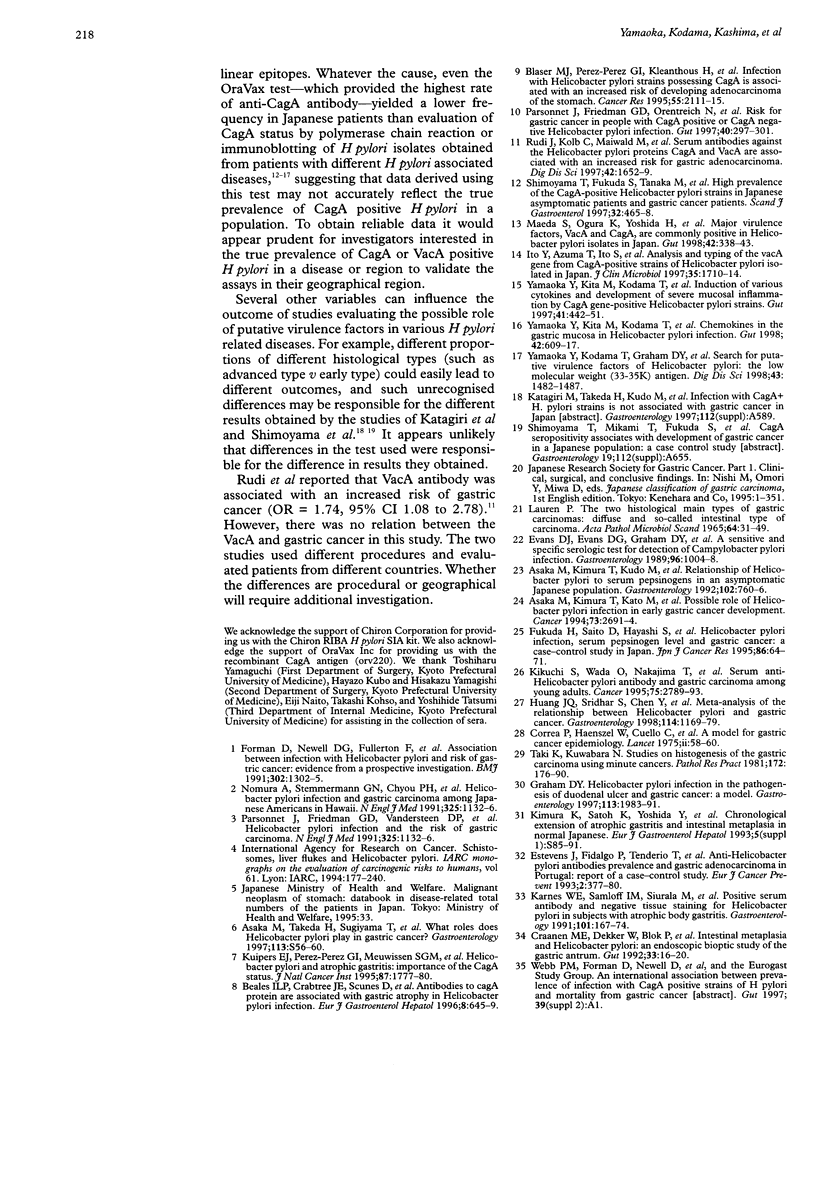Abstract
AIM: Helicobacter pylori is associated with gastric cancer. Our aim was to investigate whether CagA or VacA seropositivity provides additional risk for gastric cancer. METHODS: Sera from 110 gastric cancer patients were sex and aged matched with asymptomatic controls. H pylori status was determined by IgG enzyme immunoassay (HM-CAP EIA); CagA status was assessed by enzyme linked immunosorbent assay (ELISA) (OraVax) and immunoblotting (Chiron), and VacA status by immunoblotting using recombinant proteins as antigens. RESULTS: H pylori infection was associated with an increased risk of gastric cancer (odds ratio (OR) = 2.19, 95% confidence interval 1.17 to 4.1). Subgroup analysis showed a significant association with intestinal type (OR = 2.94, 1.35 to 6.41), distal type (OR = 2.97, 1.39 to 6.33), early gastric cancer (OR = 3.74, 1.54 to 9.06), and age < or = 55 years (OR = 8.33, 2.04 to 34.08), but not with diffuse type (OR = 0.83), proximal type (OR = 1.0), advanced gastric cancer (OR = 1.13), or age > 55 years (OR = 1.40). Serum CagA IgG and VacA antibody positivity was present in similar proportions in patients with and without cancer, with no significant differences in histological classification, clinical stage, or location (p > 0.3). CONCLUSIONS: H pylori infection causes chronic gastritis and is associated with the development of gastric cancer. Neither CagA nor VacA seropositivity added additional information or stratification.
Full text
PDF



Selected References
These references are in PubMed. This may not be the complete list of references from this article.
- Asaka M., Kimura T., Kato M., Kudo M., Miki K., Ogoshi K., Kato T., Tatsuta M., Graham D. Y. Possible role of Helicobacter pylori infection in early gastric cancer development. Cancer. 1994 Jun 1;73(11):2691–2694. doi: 10.1002/1097-0142(19940601)73:11<2691::aid-cncr2820731107>3.0.co;2-2. [DOI] [PubMed] [Google Scholar]
- Asaka M., Kimura T., Kudo M., Takeda H., Mitani S., Miyazaki T., Miki K., Graham D. Y. Relationship of Helicobacter pylori to serum pepsinogens in an asymptomatic Japanese population. Gastroenterology. 1992 Mar;102(3):760–766. doi: 10.1016/0016-5085(92)90156-s. [DOI] [PubMed] [Google Scholar]
- Asaka M., Takeda H., Sugiyama T., Kato M. What role does Helicobacter pylori play in gastric cancer? Gastroenterology. 1997 Dec;113(6 Suppl):S56–S60. doi: 10.1016/s0016-5085(97)80013-3. [DOI] [PubMed] [Google Scholar]
- Beales I. L., Crabtree J. E., Scunes D., Covacci A., Calam J. Antibodies to CagA protein are associated with gastric atrophy in Helicobacter pylori infection. Eur J Gastroenterol Hepatol. 1996 Jul;8(7):645–649. [PubMed] [Google Scholar]
- Blaser M. J., Perez-Perez G. I., Kleanthous H., Cover T. L., Peek R. M., Chyou P. H., Stemmermann G. N., Nomura A. Infection with Helicobacter pylori strains possessing cagA is associated with an increased risk of developing adenocarcinoma of the stomach. Cancer Res. 1995 May 15;55(10):2111–2115. [PubMed] [Google Scholar]
- Correa P., Haenszel W., Cuello C., Tannenbaum S., Archer M. A model for gastric cancer epidemiology. Lancet. 1975 Jul 12;2(7924):58–60. doi: 10.1016/s0140-6736(75)90498-5. [DOI] [PubMed] [Google Scholar]
- Craanen M. E., Dekker W., Blok P., Ferwerda J., Tytgat G. N. Intestinal metaplasia and Helicobacter pylori: an endoscopic bioptic study of the gastric antrum. Gut. 1992 Jan;33(1):16–20. doi: 10.1136/gut.33.1.16. [DOI] [PMC free article] [PubMed] [Google Scholar]
- Estevens J., Fidalgo P., Tendeiro T., Chagas C., Ferra A., Leitao C. N., Mira F. C. Anti-Helicobacter pylori antibodies prevalence and gastric adenocarcinoma in Portugal: report of a case-control study. Eur J Cancer Prev. 1993 Sep;2(5):377–380. doi: 10.1097/00008469-199309000-00003. [DOI] [PubMed] [Google Scholar]
- Evans D. J., Jr, Evans D. G., Graham D. Y., Klein P. D. A sensitive and specific serologic test for detection of Campylobacter pylori infection. Gastroenterology. 1989 Apr;96(4):1004–1008. doi: 10.1016/0016-5085(89)91616-8. [DOI] [PubMed] [Google Scholar]
- Forman D., Newell D. G., Fullerton F., Yarnell J. W., Stacey A. R., Wald N., Sitas F. Association between infection with Helicobacter pylori and risk of gastric cancer: evidence from a prospective investigation. BMJ. 1991 Jun 1;302(6788):1302–1305. doi: 10.1136/bmj.302.6788.1302. [DOI] [PMC free article] [PubMed] [Google Scholar]
- Fukuda H., Saito D., Hayashi S., Hisai H., Ono H., Yoshida S., Oguro Y., Noda T., Sato T., Katoh M. Helicobacter pylori infection, serum pepsinogen level and gastric cancer: a case-control study in Japan. Jpn J Cancer Res. 1995 Jan;86(1):64–71. doi: 10.1111/j.1349-7006.1995.tb02989.x. [DOI] [PMC free article] [PubMed] [Google Scholar]
- Graham D. Y. Helicobacter pylori infection in the pathogenesis of duodenal ulcer and gastric cancer: a model. Gastroenterology. 1997 Dec;113(6):1983–1991. doi: 10.1016/s0016-5085(97)70019-2. [DOI] [PubMed] [Google Scholar]
- Huang J. Q., Sridhar S., Chen Y., Hunt R. H. Meta-analysis of the relationship between Helicobacter pylori seropositivity and gastric cancer. Gastroenterology. 1998 Jun;114(6):1169–1179. doi: 10.1016/s0016-5085(98)70422-6. [DOI] [PubMed] [Google Scholar]
- Ito Y., Azuma T., Ito S., Miyaji H., Hirai M., Yamazaki Y., Sato F., Kato T., Kohli Y., Kuriyama M. Analysis and typing of the vacA gene from cagA-positive strains of Helicobacter pylori isolated in Japan. J Clin Microbiol. 1997 Jul;35(7):1710–1714. doi: 10.1128/jcm.35.7.1710-1714.1997. [DOI] [PMC free article] [PubMed] [Google Scholar]
- Karnes W. E., Jr, Samloff I. M., Siurala M., Kekki M., Sipponen P., Kim S. W., Walsh J. H. Positive serum antibody and negative tissue staining for Helicobacter pylori in subjects with atrophic body gastritis. Gastroenterology. 1991 Jul;101(1):167–174. doi: 10.1016/0016-5085(91)90474-y. [DOI] [PubMed] [Google Scholar]
- Kikuchi S., Wada O., Nakajima T., Nishi T., Kobayashi O., Konishi T., Inaba Y. Serum anti-Helicobacter pylori antibody and gastric carcinoma among young adults. Research Group on Prevention of Gastric Carcinoma among Young Adults. Cancer. 1995 Jun 15;75(12):2789–2793. doi: 10.1002/1097-0142(19950615)75:12<2789::aid-cncr2820751202>3.0.co;2-4. [DOI] [PubMed] [Google Scholar]
- Kuipers E. J., Pérez-Pérez G. I., Meuwissen S. G., Blaser M. J. Helicobacter pylori and atrophic gastritis: importance of the cagA status. J Natl Cancer Inst. 1995 Dec 6;87(23):1777–1780. doi: 10.1093/jnci/87.23.1777. [DOI] [PubMed] [Google Scholar]
- LAUREN P. THE TWO HISTOLOGICAL MAIN TYPES OF GASTRIC CARCINOMA: DIFFUSE AND SO-CALLED INTESTINAL-TYPE CARCINOMA. AN ATTEMPT AT A HISTO-CLINICAL CLASSIFICATION. Acta Pathol Microbiol Scand. 1965;64:31–49. doi: 10.1111/apm.1965.64.1.31. [DOI] [PubMed] [Google Scholar]
- Maeda S., Ogura K., Yoshida H., Kanai F., Ikenoue T., Kato N., Shiratori Y., Omata M. Major virulence factors, VacA and CagA, are commonly positive in Helicobacter pylori isolates in Japan. Gut. 1998 Mar;42(3):338–343. doi: 10.1136/gut.42.3.338. [DOI] [PMC free article] [PubMed] [Google Scholar]
- Nomura A., Stemmermann G. N., Chyou P. H., Kato I., Perez-Perez G. I., Blaser M. J. Helicobacter pylori infection and gastric carcinoma among Japanese Americans in Hawaii. N Engl J Med. 1991 Oct 17;325(16):1132–1136. doi: 10.1056/NEJM199110173251604. [DOI] [PubMed] [Google Scholar]
- Parsonnet J., Friedman G. D., Orentreich N., Vogelman H. Risk for gastric cancer in people with CagA positive or CagA negative Helicobacter pylori infection. Gut. 1997 Mar;40(3):297–301. doi: 10.1136/gut.40.3.297. [DOI] [PMC free article] [PubMed] [Google Scholar]
- Rudi J., Kolb C., Maiwald M., Zuna I., von Herbay A., Galle P. R., Stremmel W. Serum antibodies against Helicobacter pylori proteins VacA and CagA are associated with increased risk for gastric adenocarcinoma. Dig Dis Sci. 1997 Aug;42(8):1652–1659. doi: 10.1023/a:1018849112533. [DOI] [PubMed] [Google Scholar]
- Satoh K., Kimura K., Yoshida Y., Ota Y., Taniguchi Y., Kihira K., Kasano T., Takimoto T., Suzuki T., Seki M. Relationship between Helicobacter pylori and atrophic gastritis. Eur J Gastroenterol Hepatol. 1994 Dec;6 (Suppl 1):S85–S88. [PubMed] [Google Scholar]
- Shimoyama T., Fukuda S., Tanaka M., Mikami T., Saito Y., Munakata A. High prevalence of the CagA-positive Helicobacter pylori strains in Japanese asymptomatic patients and gastric cancer patients. Scand J Gastroenterol. 1997 May;32(5):465–468. doi: 10.3109/00365529709025082. [DOI] [PubMed] [Google Scholar]
- Taki K., Kuwabara N. Studies on histogenesis of the gastric carcinoma using minute cancers. Pathol Res Pract. 1981 Jul;172(1-2):176–190. doi: 10.1016/S0344-0338(81)80133-1. [DOI] [PubMed] [Google Scholar]
- Yamaoka Y., Kita M., Kodama T., Sawai N., Kashima K., Imanishi J. Induction of various cytokines and development of severe mucosal inflammation by cagA gene positive Helicobacter pylori strains. Gut. 1997 Oct;41(4):442–451. doi: 10.1136/gut.41.4.442. [DOI] [PMC free article] [PubMed] [Google Scholar]
- Yamaoka Y., Kita M., Kodama T., Sawai N., Tanahashi T., Kashima K., Imanishi J. Chemokines in the gastric mucosa in Helicobacter pylori infection. Gut. 1998 May;42(5):609–617. doi: 10.1136/gut.42.5.609. [DOI] [PMC free article] [PubMed] [Google Scholar]
- Yamaoka Y., Kodama T., Graham D. Y., Kashima K. Search for putative virulence factors of Helicobacter pylori: the low-molecular-weight (33-35 K) antigen. Dig Dis Sci. 1998 Jul;43(7):1482–1487. doi: 10.1023/a:1018850412148. [DOI] [PubMed] [Google Scholar]


